unit 3 travel journal (teaching plan)
教学设计21:Unit 3 Travel journal
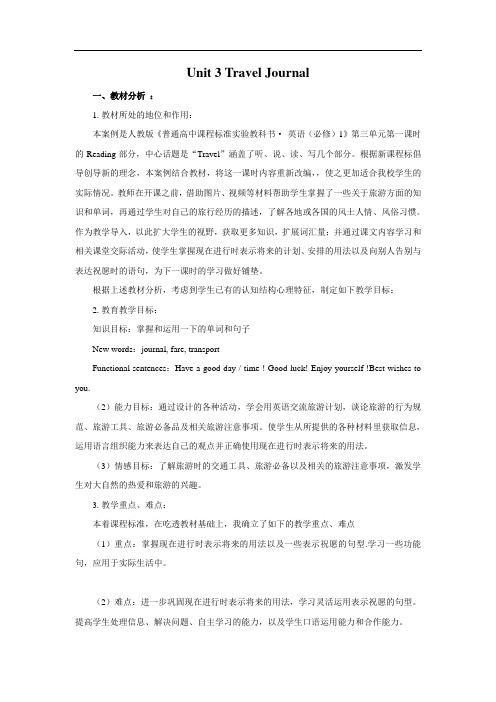
Unit 3Travel Journal一、教材分析:1. 教材所处的地位和作用:本案例是人教版《普通高中课程标准实验教科书·英语(必修)1》第三单元第一课时的Reading部分,中心话题是“Travel”涵盖了听、说、读、写几个部分。
根据新课程标倡导创导新的理念,本案例结合教材,将这一课时内容重新改编,,使之更加适合我校学生的实际情况。
教师在开课之前,借助图片、视频等材料帮助学生掌握了一些关于旅游方面的知识和单词,再通过学生对自己的旅行经历的描述,了解各地或各国的风土人情、风俗习惯。
作为教学导入,以此扩大学生的视野,获取更多知识,扩展词汇量;并通过课文内容学习和相关课堂交际活动,使学生掌握现在进行时表示将来的计划、安排的用法以及向别人告别与表达祝愿时的语句,为下一课时的学习做好铺垫。
根据上述教材分析,考虑到学生已有的认知结构心理特征,制定如下教学目标:2. 教育教学目标:知识目标:掌握和运用一下的单词和句子New words:journal, fare, transportFunctional sentences:Have a good day / time ! Good luck! Enjoy yourself !Best wishes to you.(2)能力目标:通过设计的各种活动,学会用英语交流旅游计划,谈论旅游的行为规范、旅游工具、旅游必备品及相关旅游注意事项。
使学生从所提供的各种材料里获取信息,运用语言组织能力来表达自己的观点并正确使用现在进行时表示将来的用法。
(3)情感目标:了解旅游时的交通工具、旅游必备以及相关的旅游注意事项,激发学生对大自然的热爱和旅游的兴趣。
3. 教学重点、难点:本着课程标准,在吃透教材基础上,我确立了如下的教学重点、难点(1)重点:掌握现在进行时表示将来的用法以及一些表示祝愿的句型.学习一些功能句,应用于实际生活中。
(2)难点:进一步巩固现在进行时表示将来的用法,学习灵活运用表示祝愿的句型。
Unit3__Travel_journal全单元导学案(集体备课定稿)
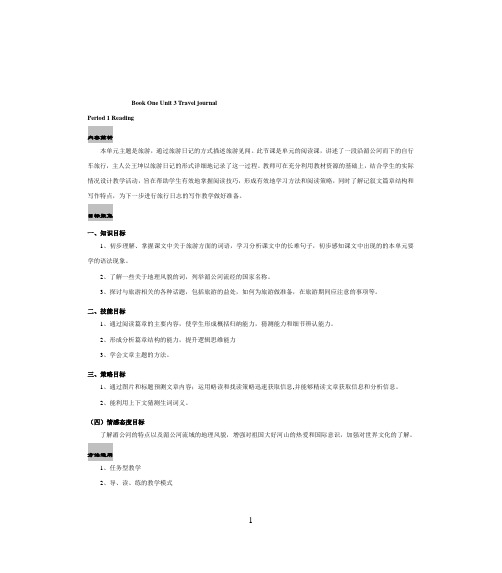
Book One Unit 3 Travel journalPeriod 1 Reading内容简析本单元主题是旅游,通过旅游日记的方式描述旅游见闻。
此节课是单元的阅读课,讲述了一段沿湄公河而下的自行车旅行,主人公王坤以旅游日记的形式详细地记录了这一过程。
教师可在充分利用教材资源的基础上,结合学生的实际情况设计教学活动,旨在帮助学生有效地掌握阅读技巧,形成有效地学习方法和阅读策略,同时了解记叙文篇章结构和写作特点,为下一步进行旅行日志的写作教学做好准备。
目标聚焦一、知识目标1、初步理解、掌握课文中关于旅游方面的词语,学习分析课文中的长难句子,初步感知课文中出现的的本单元要学的语法现象。
2、了解一些关于地理风貌的词,列举湄公河流经的国家名称。
3、探讨与旅游相关的各种话题,包括旅游的益处,如何为旅游做准备,在旅游期间应注意的事项等。
二、技能目标1、通过阅读篇章的主要内容,使学生形成概括归纳能力,猜测能力和细节辨认能力。
2、形成分析篇章结构的能力,提升逻辑思维能力3、学会文章主题的方法。
三、策略目标1、通过图片和标题预测文章内容;运用略读和找读策略迅速获取信息,并能够精读文章获取信息和分析信息。
2、能利用上下文猜测生词词义。
(四)情感态度目标了解湄公河的特点以及湄公河流域的地理风貌,增强对祖国大好河山的热爱和国际意识,加强对世界文化的了解。
方法运用1、任务型教学2、导、读、练的教学模式1学习流程Before class (课前自主学习,合作探究)Task 1 Vocabulary(词汇预习)Preview the new words of this text. 【设计意图】通过预习词汇为下一步的阅读扫清生词障碍。
Task 2 Warming up(热身)Please look at the pictures above, and think about some questions :1. Do you know where they are ? And do you like travelling?2. What should we do to prepare for a travelling?3. What kind of transport would you choose to go there?【设计意图】通过图片激发学生兴趣,引出本单元的话题旅游,并且引导学生思考旅行及旅行需要注意的问题。
Travel Journal教案

Travel Journal教案Traveljournal教案Unit3TraveljournalPartone:TeachingDesignPeriod1:AsamplelessonplanforreadingAimsTotalkabouttravelingToreadabouttravelingProceduresI.warmingup.warmingupbydiscussingGoodmorning,class.Doyouliketraveling?whydoyouliketr aveling?Andwhynot?wherehaveyoueverbeenbefore?Howdid yougetthere?Ifyouaregivenachancetotravelaroundthewo rld,whatkindoftransportationswillyouuseandwhy?Nowlo okatthefollowingpicturesanddiscussitinpairs.NameofthetransportationsmeansoftransportationReasonsbycarbybikebyplanebytrainbybusbyshipinahotballoonbymotorbikebyjeepbytruckinaplate2.warmingupbylookingandspeakingNowboysandgirls,whatdoyouneedtotakewithyouifyouarep reparingforabiketripalongthechangjiangRiver?Lookatt hepicturesandtellthewholeclasswhichobjectyouthinkis themostusefulandwhichoneistheleastuseful.Giveareaso nwhyyouthinkso.3.warmingupbyaskingandansweringNowsupposeyouliveinQinghai.youplantospendaholidaywi thafriendsomewhereinSoutheastAsia.youhavebeengivena chancetochoosethreeplacestovisit.Pleasefindouttheon e-wayfaretogettherefordifferentkindsoftransportation.Perhapsyoumaynotknowtheexactfare,butyoucanguessho wmuchthefareis.Pleasehaveashortdiscussionwithyourpa rtnersandthendecidewheretogo.ok,nowI’dlikeyoutoaskyourpartnerthefollowingquestions.II.Pre-reading.ImagingandsharingDoyouliketravelingalongariver,agreatriver?whatroledoesariverplayinpeople’slife?Inotherwords,howdopeoplewholivealongariveruse it?Thesuggestedanswers:Peoplecandrinkthewaterinariverorwashtheirclothes.Peoplecanswiminariverinsummer.Peoplecanusearivertoirrigatetheirfields.Peoplecanusearivertoproduceelectricity.Peoplecantravelalongariver.2.TalkingandsharingAsweallknow,therearealotofriversintheworldandalsoth erearemanygreatrivers.Nowlookatthechart.Intheleftcolumnarenamesofsomegreatrivers.Intherightcolumnarelo cationswheretheriverslie.Pleasematchthem.matchanswerNamesofRiverLocationNamesofRiverLocationmekongIndiamekongchina,SEAsiaRhineFranceRhineGermanyGangesRussiaGangesIndiaSeineEnglandFranceNile centralAfrica NileEgypt Thames Germany Thames England congoBrazilcongo centralAfrica Nigerchina,SEAsia Niger westAfrica VolgaUSVolgaRussiaEgyptDanubecentralEuropeAmazonwestAfricaAmazonBrazilmississippicentralEuropemississippiUSIII.Reading.ReadingaloudtotherecordingDoyouknowwhatcountriesthemekongRiverflowsthrough?No wlookatthemapofthemekongRiverandpointoutthecountrie sitflowsthrough.ok,todaywe’regoingtoreadapassageaboutjoURNEyDowNTHEmEkoNG.Plea selistenandreadaloudabouttherecordingofthetextjoURN EyDowNTHEmEkoNG.Payattentiontothepronunciationofeachwordandthepauseswithineachsentence.Iwillplaythetap etwiceandyoushallreadaloudtwice,too.2.ReadingandunderliningNowpleasereadandunderlinealltheusefulexpressionsorc ollocationsinthepassage.copythemtoyournotebookafter classashomework.collocationsfromjoURNEyDowNTHEmEkoNGdreamabout,takeagreatbiketrip,graduatefrom,gotthech ancetodosth.,cyclealongtheriver,goforlongbikerides, mountainbike,persuadesb.todosth.,growup,getsb.inter estedinsth.,bestubborn,knowthebestwayofgettingtopla ces,thesourceoftheriver,careabout,givesb.adetermine dlook,changeone’smind,atanaltitudeof,seemtodo,theairbehardtobreathe ,aninterestingexperience,makeuponesmind,givein,alar geatlaswithgoodmaps,keepdoingsth.,atfirst,passthrou gh,besurprisedtodosth.,halfof,atlast,theSouthchinaS ea3.ReadingaloudandunderstandingNextwearegoingtoreadaloudthetextandthenanswersomequ estions.)whoarewangkunandwangwei?2)whatwastheirdream?3)whoareDaoweiandyuHang?4)whereisthesourceofthemekongRiverandwhichseadoesiten ter?5)whatcanyouseewhenyoutravelalongthemekong?6)Isitadifficultjourneytocyclealongthemekong?why?4.Discussingwehavegotthegeneralmeaningofthepassage,andweknowwan gweiandwangkunhavesomesimilaranddifferentattitudesa boutthetrip.youmayhaveashortdiscussionwithyourpartn ersandthenfillinthechart.SimilarattitudesaboutthetripDifferentattitudesaboutthetripBothwangweiandwangkunthinks:).takingthistripisadreamthatcomestrue.2).thattheywillenjoythistripalot.3).theyshouldseealotofthemekong.4).thatmostofthemekongwillbefoundinSoutheastAsia.wangweibelieves:).theymuststartinQinghaiwheretheriverbegins/see allofthemekong.2).thattheydon’tneedtopreparemuch.wangkunbelieves:).itistoocoldandhightostartinQinghai.2).thatusinganatlasisveryimportant.IV.closingdownclosingdownbyansweringquestionswhatshouldyoudobeforetraveling?whatwillyourfamilyandyourfiendssaywhenyouleavehomet otravel?closingdownbytranslatingInthelastfewminutesyouareaskedtotranslatesomediffic ultysentencesinthepassage.AssignmentRevisethecontentsofthepassagecompletethepassageonPage56inworkbookDoexercise2onpage57inyouexercisebooks.Period2:AsamplelessonplanforLearningaboutLanguage AimsTolearnaboutthePresentcontinuousTenseTodiscoverandusesomeusefulwordsandexpressionsProceduresI.warmingupwarmingupbydiscoveringusefulwordsandexpressionsHelloeveryone.Afterreadingthepassage,wehavegottokno wtheusageofthewordsandexpressions,butweshoulddomorepractice.Nowturntopage20tofindthecorrectwordsandexp ressionsfromthepassagetofinishthesentences.youaregi ventwominutestofinishthemanddiscusswithyourpartners .Twominuteslater,checkinpairsandthencheckwiththewho leclass.II.Learningaboutlanguage.ReadingandfindingGood,youhavemasteredthesewordsandexpressions.Let’sturntopage17andlookatthequestionsinwarmingup4.Unde rlinetheverbsinthequestions,andpayattentiontothever bformsanddosomeexplanationsbyyourselves.2.LearningGrammarwecanseethattheverbsareallusedinthe“-ing”form.Theyare“thepresentcontinuoustense”,buttheyexpressfuturea ctionsorplans.ThePresentcontinuousTensemaybeusedtod enoteanactionthatcanbepre-plannedorprearrangedinste adofthefutureindefiniteincolloquialEnglish.Butpleas enotethat,notallverbscanbeusedinthe“-ing”formtoexpressfutureactions.Suchverbsascome,go,leave ,fly,walk,ride,drive,stay,meet,die,see,have,arriveetc.aremainlyusedinthe“-ing”formtoexpressfutureactions.3.DoingexercisesNo.2and3onpage21Nowturntopage21anddoexercise2.Inthedialogueanewspap erreporterisinterviewingwangweiaboutherplansforthet ripalongthemekongRiver.However,theyarenotsureabouts omeoftheverbtenses.canyouhelpthemcompletetheirconve rsation?Let’scontinuetodoexercise3.Doyouhaveanyplansforthefutur eyourselves?Ifyouhaveany,pleaseusethePresentcontinu ousTensetoexpressyourfutureactions.Giveasmuchinform ationasyoucan.III.Readyusedmaterialsforthepresentcontinuoustensef orfutureactionsorplansbe+v.-ing与表示将来的时间连用,表示不久的将来,含义是“预定要做”。
Unit3_travel_journal_教案
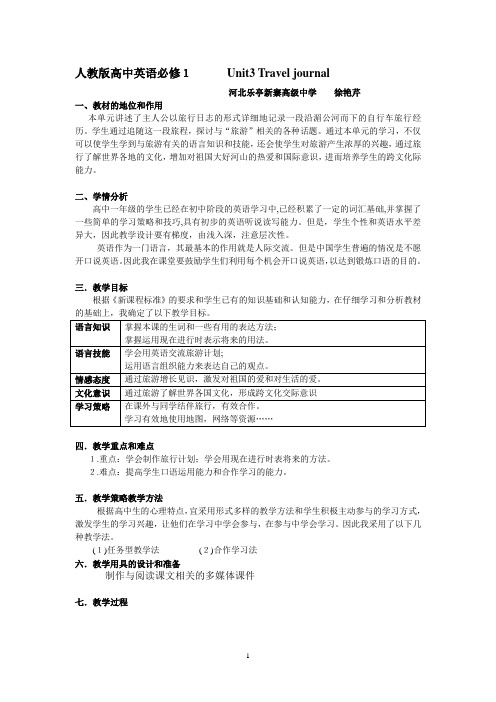
人教版高中英语必修1Unit3 Travel journal河北乐亭新寨高级中学徐艳芹一、教材的地位和作用本单元讲述了主人公以旅行日志的形式详细地记录一段沿湄公河而下的自行车旅行经历。
学生通过追随这一段旅程,探讨与“旅游”相关的各种话题。
通过本单元的学习,不仅可以使学生学到与旅游有关的语言知识和技能,还会使学生对旅游产生浓厚的兴趣,通过旅行了解世界各地的文化,增加对祖国大好河山的热爱和国际意识,进而培养学生的跨文化际能力。
二、学情分析高中一年级的学生已经在初中阶段的英语学习中,已经积累了一定的词汇基础,并掌握了一些简单的学习策略和技巧,具有初步的英语听说读写能力。
但是,学生个性和英语水平差异大,因此教学设计要有梯度,由浅入深,注意层次性。
英语作为一门语言,其最基本的作用就是人际交流。
但是中国学生普遍的情况是不愿开口说英语。
因此我在课堂要鼓励学生们利用每个机会开口说英语,以达到锻炼口语的目的。
三.教学目标根据《新课程标准》的要求和学生已有的知识基础和认知能力,在仔细学习和分析教材四.教学重点和难点1.重点:学会制作旅行计划;学会用现在进行时表将来的方法。
2.难点:提高学生口语运用能力和合作学习的能力。
五.教学策略教学方法根据高中生的心理特点,宜采用形式多样的教学方法和学生积极主动参与的学习方式,激发学生的学习兴趣,让他们在学习中学会参与,在参与中学会学习。
因此我采用了以下几种教学法。
(1)任务型教学法(2)合作学习法六.教学用具的设计和准备制作与阅读课文相关的多媒体课件七.教学过程Step1 Lead in 导入学习这节课时,学生们不久前正好从国庆节休假回来,可以充分利用这个机会,以两人对话或小组的形式来讲述每个人旅行经历,有条件的话可以和大家分享照片和视频,让他们也可以感受其中的乐趣并了解更多的旅游知识,从而引入本节课的主题:旅行计划以及旅行前的准备。
设计意图:旅游是学生比较感兴趣的话题,用这个和学生生活密切相关的话题和经历来引起学生的学习兴趣和热情。
英语:unit3《travel journal》教案(1)(新人教版必修1).doc

批注
Step1.Revision
1.Check the homework exercises .
2.Ask some students to make a dialogue,using the Present Continuous Tense for future actions .
教学重点
Develop the students’ listening ability .
教学难点
Get the students to listen and understand different listening materials .
教法与学法
Task-based listening ;cooperative learning
情感态度与
价值观
Enable the students love and enjoy nature .
Develop the student’s sense of group cooperration .
教学重点
Develop the students’ reading skills by extensicve reading .
Feel
Legs heavy and cold ,to vlimb the mountain was hard work ,but to go down the hills was great fun.can hardly wait to see their cousins
教学过程与板书设计
批注
3. Scanning
教学难点
Enable the students to learn to use reading stratagies .
高中英语 Unit 3 Travel Journal teaching plan课件 新人教版必修2
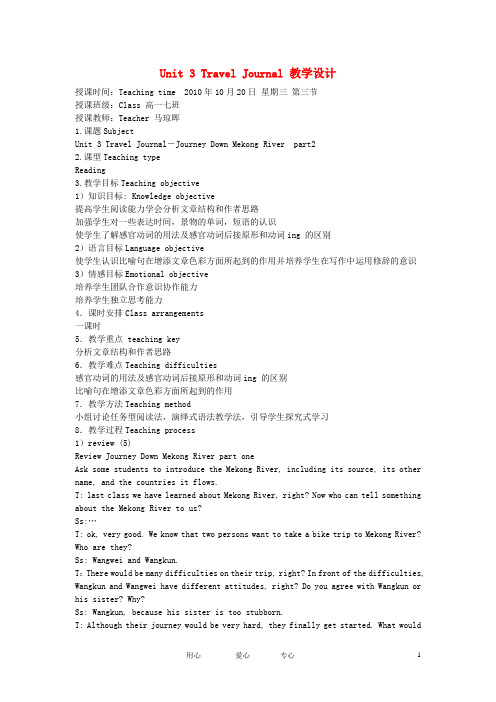
Unit 3 Travel Journal 教学设计授课时间:Teaching time 2010年10月20日星期三第三节授课班级:Class 高一七班授课教师:Teacher 马琼晖1.课题SubjectUnit 3 Travel Journal-Journey Down Mekong River part22.课型Teaching typeReading3.教学目标Teaching objective1)知识目标: Knowledge objective提高学生阅读能力学会分析文章结构和作者思路加强学生对一些表达时间,景物的单词,短语的认识使学生了解感官动词的用法及感官动词后接原形和动词ing 的区别2)语言目标Language objective使学生认识比喻句在增添文章色彩方面所起到的作用并培养学生在写作中运用修辞的意识3)情感目标Emotional objective培养学生团队合作意识协作能力培养学生独立思考能力4.课时安排Class arrangements一课时5.教学重点 teaching key分析文章结构和作者思路6.教学难点Teaching difficulties感官动词的用法及感官动词后接原形和动词ing 的区别比喻句在增添文章色彩方面所起到的作用7.教学方法Teaching method小组讨论任务型阅读法,演绎式语法教学法,引导学生探究式学习8.教学过程Teaching process1)review (5)Review Journey Down Mekong River part oneAsk some students to introduce the Mekong River, including its source, its other name, and the countries it flows.T: last class we have learned about Mekong River, right? Now who can tell something about the Mekong River to us?Ss:…T: ok, very good. We know that two persons want to take a bike trip to Mekong River? Who are they?Ss: Wangwei and Wangkun.T:There would be many difficulties on their trip, right? In front of the difficulties, Wangkun and Wangwei have different attitudes, right? Do you agree with Wangkun or his sister? Why?Ss: Wangkun, because his sister is too stubborn.T: Although their journey would be very hard, they finally get started. What wouldhappen on their journey? Do you want to know?Ss: Yes.T: ok, now please turn your book to page222) Pre-Reading (3)Ask the students to imagine what would happen on their trip in odder to stimulate their interest in reading the passage.T: We know that Wangkun and Wangwei planned to begin their trip from the source of Mekong River. It is very cold and hard to breathe. But Wangwei and Wangkun did not change their mind and begin their bike trip from the source of Mekong River in Qinghai province. What would happen on the trip? Who can imagine?S1:S2;3) Reading (15)A): Ask students to read the passage following the tapes and try to imitate the pronunciation and asking the following questions.Is their trip hard or easy?Do they like this trip?Find the expressions about time in the passage.T: Do you get the main idea of the passage? Ok, now please tell me; is their trip hard or easy? Do they like this trip? Do you find expressions about time in the passage? Who can tell me?Ss:…T: OK, now please look at the blackboard.B): Ask students to read the passage in group and complete the following tasks in group work. (8)Group1: How did the weather change as time went by?Group2: What did they see on their trip?Goup3: What did they do?T: Ok please read the passage in groups. Before you go, please look at the table. There are several expressions about time in the passage. They are…After you have finished reading the passage, please try to finish the table. The first group is asked to fill the first line, the second group to fill the second line, and the third group to fill the third line.c) Ask students to find out three metaphor sentences in the passage (10)T: There are three metaphor sentences in the passage, who can tell me what they are. And you can just tell one of them.Ss: Have you ever see snowman ride bicycles?The lake shone like glass in the setting sun.We found ourselves cycling through clouds.d) Ask students to find out the following three sentences in the passage and make comparison between them.T: could you please find out three sentences in the passage.The first one “Have you ever see snowman ride bicycles.”The second one “we found ourselves flying through clouds”The last one “we saw many yaks and sheep eating green grass.”Please draw line under these sentences.(The teacher analyze the grammar point to the students)Sb see/hear/find/ sb/sth do sth. 表示看到全过程或曾经看到过听到过感受过。
必修一Unit-3-Travel-Journal教学设计
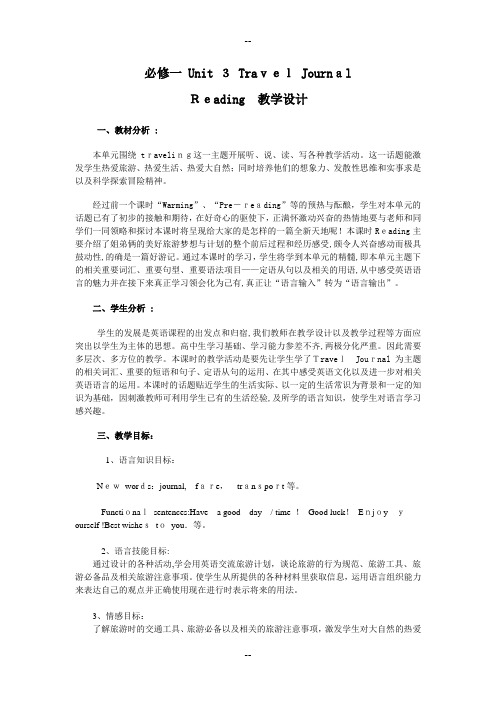
必修一 Unit 3Travel JournalReading 教学设计一、教材分析 :本单元围绕traveling这一主题开展听、说、读、写各种教学活动。
这一话题能激发学生热爱旅游、热爱生活、热爱大自然;同时培养他们的想象力、发散性思维和实事求是以及科学探索冒险精神。
经过前一个课时“Warming”、“Pre-reading”等的预热与酝酿,学生对本单元的话题已有了初步的接触和期待,在好奇心的驱使下,正满怀激动兴奋的热情地要与老师和同学们一同领略和探讨本课时将呈现给大家的是怎样的一篇全新天地呢!本课时Reading主要介绍了姐弟俩的美好旅游梦想与计划的整个前后过程和经历感受,颇令人兴奋感动而极具鼓动性,的确是一篇好游记。
通过本课时的学习,学生将学到本单元的精髓,即本单元主题下的相关重要词汇、重要句型、重要语法项目——定语从句以及相关的用语,从中感受英语语言的魅力并在接下来真正学习领会化为己有,真正让“语言输入”转为“语言输出”。
二、学生分析 :学生的发展是英语课程的出发点和归宿,我们教师在教学设计以及教学过程等方面应突出以学生为主体的思想。
高中生学习基础、学习能力参差不齐,两极分化严重。
因此需要多层次、多方位的教学。
本课时的教学活动是要先让学生学了TravelJournal为主题的相关词汇、重要的短语和句子、定语从句的运用、在其中感受英语文化以及进一步对相关英语语言的运用。
本课时的话题贴近学生的生活实际、以一定的生活常识为背景和一定的知识为基础,因刺激教师可利用学生已有的生活经验,及所学的语言知识,使学生对语言学习感兴趣。
三、教学目标:1、语言知识目标:Newwords:journal,fare,transport等。
Functionalsentences:Have a good day/ time !Good luck!Enjoyyourself !Best wishestoyou.等。
2、语言技能目标:通过设计的各种活动,学会用英语交流旅游计划,谈论旅游的行为规范、旅游工具、旅游必备品及相关旅游注意事项。
英语必修一unit3教案
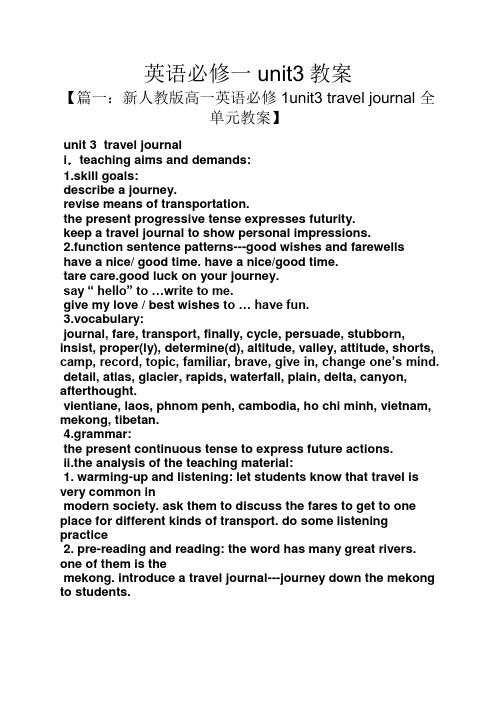
英语必修一unit3教案【篇一:新人教版高一英语必修1unit3 travel journal 全单元教案】unit 3 travel journali.teaching aims and demands:1.skill goals:describe a journey.revise means of transportation.the present progressive tense expresses futurity.keep a travel journal to show personal impressions.2.function sentence patterns---good wishes and farewellshave a nice/ good time. have a nice/good time.tare care.good luck on your journey.say “ hello” to …write to me.give my love / best wishes to … have fun.3.vocabulary:journal, fare, transport, finally, cycle, persuade, stubborn, insist, proper(ly), determine(d), altitude, valley, attitude, shorts, camp, record, topic, familiar, brave, give in, change one’s mind. detail, atlas, glacier, rapids, waterfall, plain, delta, canyon, afterthought.vientiane, laos, phnom penh, cambodia, ho chi minh, vietnam, mekong, tibetan.4.grammar:the present continuous tense to express future actions.ii.the analysis of the teaching material:1. warming-up and listening: let students know that travel is very common inmodern society. ask them to discuss the fares to get to one place for different kinds of transport. do some listening practice2. pre-reading and reading: the word has many great rivers. one of them is themekong. introduce a travel journal---journey down the mekong to students.3.learning about language: in this part, students will discover useful words and expressions and also learn useful structures---- the present continuous tense to express future actionsing language: present how to write a travel journal and then practise writing iii.teaching arrangment1stperiod 2nd period 3rd period 4thperiodwarming-up and listening reading learn about languageusing languagethe first period warming-up and listeningteaching aims1. to talk about things related to travel, e.g. the place the fares and transport, etc.2. to improve the ss’ listening ability.teaching important points1. to talk about travel.2. to tell the ss how to catch the key points when they do listening.emotion goals:there are so many beautiful places in china and the whole world. we should love our country, love the whole world and love nature.teaching aidsa tape recorder, a projector and a computerstep 1. a song (歌词见后面)step 2 warming upshow the photos of some beautiful places on the powerpoint. (the great wall; yuanming yuan ; budala palace; venice; the liberty statue in new york,america; fujiyama.)ask students whether they know where they are.then t ask: do you like traveling? ss: yest: why do you like traveling? (超级链接):enjoy beautiful scenery; increase our knowledge; make friends; be good to health…ss may have a lot of different ideas. give them time to talk freely.t ask: how will you prepare for traveling? (including the time, the place, the means, the cost, the things you’ll take along, … of traveling) (超级链接) :1. time (超级链接):the spring festival; national day; may day; weekend; summer( winter) vacation…2.destination(超级链接): enjoy some beautiful pictures of famous places with the whole class: huangshan黄山; jiuzhaigou九寨沟; guilin桂林; stone forest(石林); jiuquxi(九曲溪; yunufeng,wuyi(武夷玉女峰); sanqing mountain三清山; hangzhou;longmen caves (龙门石窟);tian’anmen square(天安门广场);terracotta,xi’an(西安兵马俑); summer palace(颐和园); london bridge;the opera house悉尼歌剧院; eiffel tower艾菲尔铁塔.3.what to do(超级链接): rock climbing; rafting; bengee; skiing; hikingallow the ss to talk more about it.4.travel cost: talk with the ss quickly.5.things to take(超级链接): id cards(身份证) passports; money (cash); a book of maps; 等。
人教版选修一英语unit3教案

人教版选修一英语unit3教案Unit 3 Travel journal【Introduction】In this unit, we will read a travel journal written by a young backpacker named Joe. Through Joe's vivid and detailed descriptions, we will learn about his unforgettable adventures and experiences during his solo trip around Southeast Asia. This travel journal not only introduces us to the diverse cultures and breathtaking landscapes of this region but also provides us with valuable insights into the challenges and rewards of independent travel.【Tasks and Goals】1. Develop students' reading comprehension skills.2. Improve students' ability to analyze and interpret the author's point of view.3. Enhance students' vocabulary and language skills related to travel and cultural exploration.4. Encourage students to reflect on the importance of stepping out of their comfort zones and embracing new experiences.【Teaching Procedures】Step 1: Pre-reading (15 minutes)- Introduce the topic of the travel journal to capture students' interest.- Activate students' background knowledge by asking them about their travel experiences or dreams.- Show some pictures of famous landmarks in Southeast Asia to generate discussion and engage students.Step 2: Reading (30 minutes)- Distribute copies of the travel journal to each student.- Ask students to read the journal silently and underline any unknown words or phrases.- Conduct a guided reading session, focusing on comprehension and analysis of the text.- Encourage students to discuss their interpretations and impressions of the journal with their peers.Step 3: Vocabulary and Language Focus (20 minutes)- Select key vocabulary words from the journal andpresent them to the students.- Engage students in various vocabulary activities suchas matching exercises and context-based sentence completion.- Teach idiomatic expressions and collocations related to travel.- Provide opportunities for students to practice usingthe new vocabulary in oral and written activities.Step 4: Post-reading and Discussion (25 minutes)- Facilitate a class discussion on the themes and messages conveyed in the travel journal.- Encourage students to share their own travelexperiences or aspirations, and how they relate to the ideas presented in the journal.- Challenge students to reflect on the importance of cultural understanding and empathy when embarking on new adventures.- Conduct a group activity where students work togetherto create their own travel journals, using Joe's journal as a model.Step 5: Consolidation and Assessment (15 minutes)- Assign a writing task where students need to summarize their favorite part of Joe's travel journal and explain whyit resonated with them.- Evaluate students' comprehension and analysis skills through written or oral assessments.- Provide individual feedback and guidance for improvement.【Conclusion】Through studying Joe's travel journal, students will gain valuable insights into the world of independent travel and broaden their horizons. This unit aims to foster a sense of curiosity, empathy, and cultural awareness among students, while improving their English language skills. By the end of the unit, students should be able to appreciate the transformative power of travel and understand the importance of embracing new experiences.。
教学设计:Unit 3 Travel journal

Unit 3 Travel JournalI. Analysis of the teaching contentsThis unit, unit 3 travel journal, is from New Senior English for China Student’s Book 1. The topic of this unit centers on travel and travel journal, including the travel plan, where to travel, how to travel and so on. Travel is very attractive to the students. But before traveling, we must do a lot of work. The reading material is about how they make their travel plan and how to carry out their plan. The students can learn how to describe their attitudes and how to make a travel plan if they want to travel. Travel is a very beneficial and attractive activity. One can gains a lot, such as, general knowledge of geography, politics, communicate skills and travel experience. In this unit, language study includes some new words and useful expressions and the present continuous tense.II. Analysis of characteristics of the learnersStudents who learn this unit are in their Senior One. They have the basic ability to read the passage and know how to make their plans and show their attitudes towards something. But they don’t have very large vocabulary. Therefore, they have some difficulties in understanding the reading material completely. So, to master the new words in this unit is very important. Students in their age are active but afraid of making mistakes and they have few chances to express themselves in English. In this case, teac her’s guidance and courage are the keys to students’ progress. Students may feel bored if there is only boring knowledge. We can combine the passage and some knowledge with their interests so that they can be more devoted in the study.III. Teaching aimsA.Knowledge1.The students should learn how to use the key words and expressions in this unit, such as, prefer todo sth. prefer sth to sth., be fond of, attitude and so on.2.The students learn to use the present continuous tense to express future actions.B.Ability1.The students will make some team and learn to make a travel plan or a study plan together and carryout it if the condition is mature.2.The Ss learn to express their attitudes to something, someone or some methods.3.The students should know what eco-travel is,and plan an eco-travel for the nearest holidays.4.The students learn to write a letter to their friends or relatives, to write a travel journal and atravel advertisement.C.Emotion and attitude1.Develop Ss’ sense of eco-travel and make them protect the environment while traveling.2.The students will learn that travel also need courage, perseverance and some common sense.3.They will develop students’ cooperative spirit.IV. Teaching methodologyGenerally, the method is task-based language teaching. Details are as follows:1.Discussion to help the students know something about travel: the transport, the travel budget. Picturesto show the natural environment of the Mekong river.2.Fast reading to help the students to get the general idea of the passage.3.Careful reading to get the students to understand some detailed information.4.Pair work to develop the students’ cooperative spirit and encourage them to speak English in class.5.Retell to help students to review the passage .V. Learning strategyVI. Important points of teaching1.Master the new words and phrases in this unit.2.Help the students to get a better understanding of the text.3.Help the students to make a prese ntation on one’s own travel plan.VII. Difficult point of teaching1.Express fluently their travel plan and wishes.2.Grasp the main idea of the text and how to tell the writer’s attitude.3.Plan an eco-travel for the nearest holiday.VIII. Teaching proceduresStep 1. Warming upShow some beautiful pictures around the worldGoal: This step is to arouse the students’ interest in the unit.Step2. Background informationLet the students’ say something about travel and the Mekong River and then, teacher will give some pictures of the Mekong River.Goal: To enrich their background knowledge.Step3: ReadingA.Pre-readingB.While-readingC.Post-readingGoal: Improve the students’ ability of exchanging ideas and let them get the general idea of the given passage through skimming and scanning. And gain the knowledge of some common sense and the words, phrases and grammar points.Step4: ExercisesGoal: Do some exercises to review what have learned before. Pair work to tr ain students’ ability of speaking and cooperative spirit.Step5: HomeworkGoal: To let the students consolidate what they have learnt and improve their writing ability.Step6: SummaryIX. Teaching contents1.Lead-in and Warming-upShow some pictures or postcards of some places of interest and beautiful travel destinations and vocation resorts on the screen and tell them the places of interests in the world. And then ask them if they like traveling. They may answer yes, and I continue to ask where they have been.T: Ok, boys and girls, do you like traveling?Ss: Yes.T: Where have you been before? And how did you find your travel?Possible answers:(Here the students’ answers are probably different. They may answer that they have been to Beijing, Shanghai, Guangzhou, Qingdao, Fuzhou, Xiamen and some other place. And they may find their travel is interesting, funny, impressive, unforgettable, wonderful, comfortable and so on.)(In 3-4 minutes)Then I tell them that on this National Day I paid a visit on Shanghai with my friends. We visited Oriental Pearl,which is the nickname of Shanghai. It took me 10 hours to get there by train. What’s more, I spent a lot of money for this travel. Then show the pictures of Oriental Pearl and Huangpu River to the students on the screen. And present a table about the fare, the transport, the date, and the destination on the screen.However, what’s more important, I learned a lot from this travel. Not only could I enjoy the places of interest, but also I could learn about many local customs, cultures and the history of some places of interest. So I think it is very interesting and helpful.Meanwhile, with the help of multimedia, I’ll also show some pictures of different kinds of transports and help the students to revise them, including by car, by bus, by ship, by train, by air etc. However, each transport has its own advantages and disadvantages. Now please list some advantages and disadvantages of each transport after discussion with your partners. (In3 minutes or so)Then I will ask some of them to show their answers. At last, I summarize and present the main answers on the screen. (In 4 minutes or so)Who are you going with?How are you traveling?Which river will you choose?What will you prepare?From where will you start?When are you coming back?Step2 Background informationWith the help of multimedia, I’ll show some pictures of the Mekong River and introduce the basic information, such as the length, the countries that it flows through, where it ends, how it looks like and so on. Also, I will help the students to revise the transports and asked them if we want to travel the Mekong River, what transports should we choose.The Mekong is a river in Southeast Asia. It is the world's 12th-longest river and the 7th-longest in Asia. Its estimated length is 4,350 km (2,703 mi),and it drains an area of 795,000 km2(307,000 sq mi), discharging 475 km3 (114 cu mi) of water annually.From the Tibetan Plateau this river runs through China's Yunnan province, Burma, Laos, Thailand, Cambodia and Vietnam. Laos, Thailand, Cambodia and Vietnam established the Mekong River Commission (MRC) in 1995 to assist in the management and coordinated use of the Mekong's resources. In 1996 China and Burma became "dialogue partners" of the MRC and the six countries now work together within a cooperative framework.The extreme seasonal variations in flow and the presence of rapids and waterfalls in this river have made navigation difficult. Two hundred Chinese border police and 100 policemen from Myanmar, Laos and Thailand escorted a convoy of 10 Chinese cargo ships departing Guanlei, China, recently. The river is a major trading route linking China’s southwestern province of Yunnan to the South China Sea via Myanmar, Laos, Thailand, Cambodia and Vietnam, and provides locals with an invaluable outlet to the sea and international trading.Step3 Reading1.Pre-readingCan you guess what the names of these rivers are? (In 1 minute)Changjiang (Yangtze) Yellow2.3.4.5.6.7.8.9.Nile AmazonHow do people living along a river make use of it? (Individual work in this part)To irrigate the fieldsTo go swimming in it in summerTo make electricityTo travel along itOk, now please look at the map on page 18 and list the countries that the Mekong River flows through. (review)Mekong RiverThe countries that the Mekong River flows through: China's Yunnan province, Burma, Laos, Thailand,Cambodia and Vietnam2.While-readingAsk the students to scan the text and think about the following questions.A.What Is the text about?B.What was Wang Kun and Wang Wei’s idea of a good trip?Their idea was to take a long bike trip.C.Who planned the trip to the Mekong?Wang Wei.Ask the students to read the text more carefully and answer more questions.D.Where is the source of the Mekong River and which sea does it enter?The source of the river is in Qinghai Province and it enters the South China Sea.E.What can you see when you travel along the Mekong River?You can see glacier, rapids, hills, valleys, waterfalls and plains.F.What difficulties did Wang Kun and Wang Wei find about their journey?The journey will begin at an altitude of more than 5,000 metres, where it is hard to breathe and very cold.G.What do you think about Wang Kun and Wang Wei?Wang Kun is enthusiastic, critical, and sensible, while Wang Wei is imaginative, organized, eager, persistent, stubborn and risk-taking.3.Post-readingA.After they complete these questions, I’ll ask the students to read the text following the tape. And thenunderline the difficult sentences and some important expressions and phrases. Then I will explain then in next class.B.Ask the students to simply retell the story in their own word and then tell others Wang Kun’s and WangWei’s attitudes to this journey.Step 4: Exercisesnguage exercises: Discovering useful words and expressions, Discovering useful structures.B.Work in pair. Imagine that you are Wang Kun or Wang Wei. Choose a paragraph from the passage anduse the information to help you make up a dialogue.Wang Wei: You know, we’ve always wanted to do a long bike trip. Why don’t we go on after we graduate from college?Wang Kun: That is a good idea. …Step 5: HomeworkWrite a short passage of your travel plan.Step6. SummaryNow, let’s sum up what you have learnt about traveling.From this unit, you have also learned:Useful words:Useful phrases:A new grammar item:Other ability that you have gained:。
Unit 3Travel Journal教案

Unit 3 Travel Journal 教案教学目标【知识目标】To learn about the words and phrases about geographyTo know about the Mekong RiverTo understand the character of Wang Kun and Wang Wei【能力目标】Learn to read a mapImprove Ss’ reading skills (skimming and scanning)【情感目标】Know to respect and communicate with others when having different opinions Know to love and protect the rivers in the world教学重难点【教学重点】Help Ss to improve their reading skillsH elp Ss to understand the author’s trip down the Mekong River【教学难点】Help Ss to understand Wang Kun’s and Wang Wei’s attitudes to the trip Help Ss to analyze the characters of Wang Kun and Wang Wei【考点同步解读】一、重点短语1. travel----泛指旅行journey----指长时间长距离的陆上旅行voyage----指长距离的水上旅行,也可以指乘飞机旅行trip----常指短时间短距离的旅行tour----指周游,巡回旅游,2. prefer to 更加喜欢,宁愿 prefer A to B 比起B,更喜欢Aprefer doing to doing 比起做…,宁愿做…prefer to do rather than do 与其做…, 不如…3. flow through 流过,流经4. ever since 自从5. persuade sb. to do sth. 说服某人做某事6. be fond of 喜欢7. insist on doing 坚持做某事 insist + that 从句(用should+ V原)8. care about 关心. change one’s mind 改变想法10. altitude 高度attitude 态度,看法11. make up one’s mind to do下定决心做某事 = decide to do = make a decision to do12. give in 让步,屈服give up 放弃13. be surprised to …对…感到惊奇to one’s surprise 令某人惊讶的是…14. at last = finally = in the end 最终15. stop to do 停下来去做某事stop doing 停止做某事16. as usual 像往常一样17. so…that如此…以至于… So + adj + a/an + n. + thatSuch + a/an +adj. + n. + that18. be familiar with 对…熟悉(人作主语)be familiar to 为…所熟悉(物作主语)二、语法:现在进行时表将来现在进行时表将来,表示最近按计划或安排要进行的动作,常见的现在进行时表将来的动词有:come/ go / leave/ arrive / travel / take / stay/ do等.【核心素养聚焦】1. Encourage students to learn more about traveling and tourist culture2. Enable students to become more interested in traveling and experience the beauty of nature so as to be fond of nature.3. Train the students’ ability to cooperate with others4. Try to make the students to use some useful words and expressions correctly5. Try to make the students to review the useful sentence patterns6. Train the students to interest in learning English课前准备Tape recorder, Multimedia教学过程Step1. Warm-upA competition between groups:1)Which country is Mississippi River located in?2)Which country is Thames River located in?3)Which river is the longest river in the world?4)Which river is the second longest river in the world?5)Which river is the longest river in China?6)Which river is the most important river in Southeast Asia?【设计意图】通过小组竞赛激发学生参与课堂的积极性,并让学生了解和积累世界河流的知识,为进一步阅读理解文章做准备。
高一unit3 travel journal 英文教案
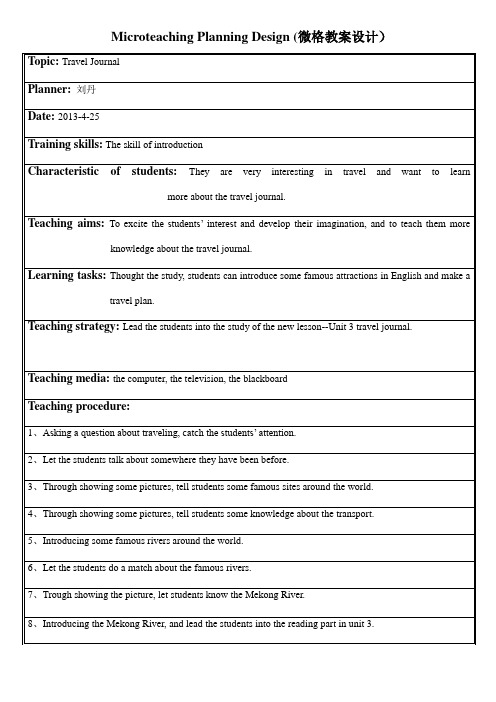
Microteaching Planning Design (微格教案设计)Topic: Travel JournalPlanner:刘丹Date: 2013-4-25Training skills: The skill of introductionCharacteristic of students: They are very interesting in travel and want to learnmore about the travel journal.Teaching aims: To excite t he students’ interest and develop their imagination, and to teach them more knowledge about the travel journal.Learning tasks: Thought the study, students can introduce some famous attractions in English and make a travel plan.Teaching strategy: Lead the students into the study of the new lesson--Unit 3 travel journal.Teaching media: the computer, the television, the blackboardTeaching procedure:1、Asking a question about traveling, catch the students’ attention.2、Let the students talk about somewhere they have been before.3、Through showing some pictures, tell students some famous sites around the world.4、Through showing some pictures, tell students some knowledge about the transport.5、Introducing some famous rivers around the world.6、Let the students do a match about the famous rivers.7、Trough showing the picture, let students know the Mekong River.8、Introducing the Mekong River, and lead the students into the reading part in unit 3.Microteaching Planning (微格教学教案)Subject: EnglishTopic: Travel JournalPlanner:刘丹Date: 2013-4-25Teaching aims: To excite the students’ interest and develop their imagination, and to teach them more knowledge about the travel journal.Time Teaching behavior Teachingskills Learning activities Teaching media30s Good morning, boys and girls.How are you today?I’ m fine, thanks.Today,we will learn the unit 3 traveljournal.Let students beready for newlesson.Good morning, Miss Liu.I’ m fine, and you?OK.1m 1、Before the class, i have two questionsfor you.2、Do you like traveling?3、Where have you been before?Any volunteers? OK, you please.4、That is wonderful! If I have a chance,I want to go there, too. Any othervolunteers? #, please.5、I think you have been many beautifulplaces before, right?To excite thestudents’interest aboutthe newlesson.1、Yes, I do.2、#Beijing, Tianjin#Yunnan, XiamenComputerandtelevision1、And now, i want to show you morefamous tourist attractions around theworld.1、Yes.3m Let’ s guest where is it.Are you ready?2、No.1, where is it?3、Yes. It is the Tienanmen Square inBeijing. And next one? Any one knowabout that?4、It is the Victoria Harbour in HongKong. It is the important part of HongK ong’ s economic. And next one. What isit?5、Yeah, it is the Eiffel Tower. ThanChinese people called it 巴黎铁塔or埃菲尔铁塔.6、I would like to travel there becausethey are so great! Do you?To tell studentssome famoussites around theworld and holdthe students’attention aboutthe travel. 2、Tienanmen Square.3、Hong Kong.4、巴黎铁塔。
北师大版高中英语必修一第三单元教案
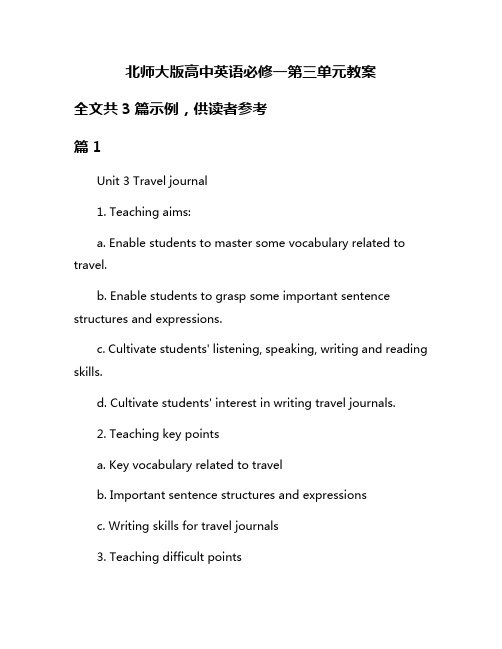
北师大版高中英语必修一第三单元教案全文共3篇示例,供读者参考篇1Unit 3 Travel journal1. Teaching aims:a. Enable students to master some vocabulary related to travel.b. Enable students to grasp some important sentence structures and expressions.c. Cultivate students' listening, speaking, writing and reading skills.d. Cultivate students' interest in writing travel journals.2. Teaching key pointsa. Key vocabulary related to travelb. Important sentence structures and expressionsc. Writing skills for travel journals3. Teaching difficult pointsa. How to use the vocabulary and sentence structures in practical situations.b. How to write a coherent and interesting travel journal.4. Teaching aidsa. Multimedia resourcesb. Whiteboard and markers5. Teaching proceduresStep 1: Warm-up (10 minutes)a. Show students some pictures of famous tourist attractions around the world and ask them if they have ever been to any of them.b. Discuss with students the reasons why people travel and the benefits of traveling.Step 2: Vocabulary learning (15 minutes)a. Introduce some key vocabulary related to travel, such as "destination", "sightseeing", "accommodation", "itinerary", etc.b. Have students practice using the vocabulary in sentences.Step 3: Listening and speaking practice (20 minutes)a. Play a recording of a travel journal entry and have students listen carefully.b. Ask students to discuss in pairs or small groups about their own travel experiences and share them with the class.Step 4: Writing practice (30 minutes)a. Introduce the format and structure of a travel journal entry.b. Have students write their own travel journal entry about a trip they have taken or would like to take.c. Provide feedback and corrections on students' writing.Step 5: Review and assessment (15 minutes)a. Review the key vocabulary and sentence structures learned in the lesson.b. Have students present their travel journal entries to the class for assessment.6. Homeworka. Ask students to continue their travel journal entries at home and bring them to the next class for review.b. Assign some exercises related to the vocabulary and sentence structures learned in the lesson for further practice.Through this lesson, students will not only improve their English language skills, but also develop a greater appreciation for the art of travel journal writing.篇2北师大版高中英语必修一第三单元教案Unit 3 Travel journalⅠ. Teaching aims and requirements1. Knowledge aims:(1) Get to know some news words: trek, snowcapped, spiritual, kingdom, Kingdom, camel.(2) Understand the main idea of each para., comprehend some detailed information to Mary and Mood.(3) Practice reading skills: skimming and scanning.2. Ability aim:Improve students’ abilities of listening, speaking, reading and wring. Learn how to express travel through it.3. Emotion aim:(1) Cultivate students’ travel mind and prepare their travel ideas.(2) Learn to respect, peaceful and grateful.4. Moral aim:Learn to natural world to love, to know animals and treasure life’s creatures.Ⅱ. Teaching key points1. Summary the passage: Why does Mary Bishop come to the Nepal Himalaya?2. How did she feel after leaving the snow-capped mountain?3. What about another member’s mood?Ⅲ. Teaching difficult points1. Improve students’ summarizing ability.2. Ingrain climate.Ⅳ. Teaching aidsA recorder, a computer and multi-media.Ⅴ. Teaching methodsTask-based teaching. Communicative approach.Ⅵ. Teaching proceduresStep Ⅰ: Lead-in1. Show some cards about the animals and choose the most important animal in their heart.2. Ask: Why do they feel meet?3. Listen to the tape for warming up.Step Ⅱ: Pre-reading.Predict what they may feel during trekking in the Himalayas and give their an example then scan Task1Q1.Step Ⅲ: Reading1. Students read the passage quickly and choose the answer about Mary loses while trekking.2. To teacher’s questions: What’s wrong with Mary’s friend?3. Analyze detailed information of Mood.4. Check the work and ask some questions to each other and fill in the blanks.Step Ⅳ: Comprehension1. Listen to Task2Q2 to particular. They can draw a map to explain that she arrives in Jiri and then to Sethopsar.2. Find the detailed from the passage and fill in the blanks.3. Pair works to discuss mood for 2 minutes.Step Ⅴ: Language practice1. Help student to speak: In pairs. Practice speaking these dialogues.2. To help them to translate Chinese into English.Step Ⅵ: SummaryAsk students to try their best to speak in English about their thoughts when meet animals in trekking.Step Ⅶ: Homework1. Choose another paragraph to summarize.2. Writing an essay with their parents talking about experience of trekking.Ⅶ. Blackboard designUnit 3 Travel JournalMain Idea: Why does Mary Bishop come to the Nepal Himalaya?a) ...........b)...............c)…………Task 1Fill in the blanks.1. The writer saw many ---------.2. There was a dog following the trek who tried to--------.3. In the evening, they camped in a beautiful ---------.Task 2Write down your answers in the passage.1. Travel to Tsomanthang.2. Go to Sethopsar.ConclusionImprove students' summarizing and comprehension abilities.篇3Lesson 3 One's company, two's a crowd, three's a party【Teaching Aims】1. Enable students to master the key words and expressions in the text.2. Improve students' listening, speaking, reading and writing skills.3. Develop students' ability to express their opinions and thoughts in English.4. Cultivate students' understanding of different cultures and social norms.【Teaching Key Points】1. Key words and expressions in the text.2. Listening comprehension.3. Speaking practice based on the text.4. Writing a short paragraph expressing personal opinions.【Teaching Difficult Points】1. Listening comprehension.2. Expressing personal opinions and thoughts in English.【Teaching Methods】1. Task-based teaching method.2. Group discussion.3. Pair work.4. Role play.5. Multimedia teaching.【Teaching Procedures】Step 1: Greeting and warm-up (5 minutes)- Greet the students and introduce the topic of the lesson.- Ask students to discuss in pairs: "What do you think makes a good party?"- Have a brief class discussion to share ideas.Step 2: Pre-reading task (10 minutes)- Ask students to look at the title of the text and predict what it might be about.- Play a short video clip of a party scene and ask students to describe what they see and how they feel.Step 3: Reading and listening (20 minutes)- Read the text aloud and ask students to read along silently.- Play the audio recording of the text for students to listen and follow.- Discuss the main ideas, key words, and expressions in the text.Step 4: Reading comprehension (15 minutes)- Divide students into pairs or small groups to discuss and answer the comprehension questions.- Check the answers as a class and provide feedback.Step 5: Speaking practice (20 minutes)- Divide students into groups and assign roles for a role play activity about planning a party.- Encourage students to use the key words and expressions from the text in their conversations.- Monitor and provide feedback on their speaking skills.Step 6: Writing (15 minutes)- Ask students to write a short paragraph expressing their opinions on the importance of social gatherings.- Collect and review the paragraphs for grammar and vocabulary errors.Step 7: Summarizing and homework (5 minutes)- Summarize the key points of the lesson and ask students to review the text for homework.- Assign a writing task for students to write a party invitation using the key words and expressions from the text.【Teaching Reflection】This lesson aims to engage students in a variety of activities to improve their English skills while exploring the theme of social gatherings. By focusing on listening, speaking, reading, and writing tasks, students are able to practice and consolidate their language skills in a meaningful context. The use of multimedia and interactive activities helps to create a dynamic and engaging learning environment.。
《Unit 3 Travel journal》教学设计
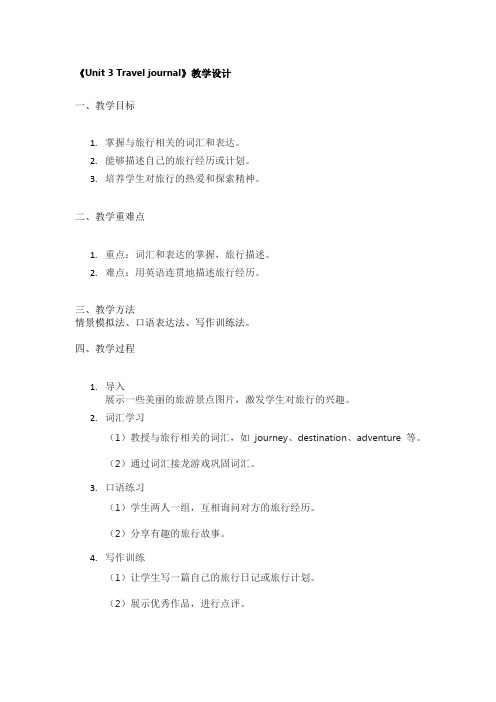
《Unit3Travel journal》教学设计
一、教学目标
1.掌握与旅行相关的词汇和表达。
2.能够描述自己的旅行经历或计划。
3.培养学生对旅行的热爱和探索精神。
二、教学重难点
1.重点:词汇和表达的掌握,旅行描述。
2.难点:用英语连贯地描述旅行经历。
三、教学方法
情景模拟法、口语表达法、写作训练法。
四、教学过程
1.导入
展示一些美丽的旅游景点图片,激发学生对旅行的兴趣。
2.词汇学习
(1)教授与旅行相关的词汇,如journey、destination、adventure等。
(2)通过词汇接龙游戏巩固词汇。
3.口语练习
(1)学生两人一组,互相询问对方的旅行经历。
(2)分享有趣的旅行故事。
4.写作训练
(1)让学生写一篇自己的旅行日记或旅行计划。
(2)展示优秀作品,进行点评。
5.课堂小结
总结旅行相关的词汇和表达,以及如何描述旅行。
6.作业布置
(1)制作一份自己梦想旅行地的海报,用英语介绍。
(2)阅读一篇关于旅行的英语文章。
英语人教必修一Unit-3-Travel-Journal-【教学设计】

Unit 3 Travel Journal教材分析本单元的话题是旅游,学生对此话题较为熟悉,应该有较浓厚的兴趣。
整个单元讲述的是主人公“王坤”以旅行日记的形式详细地记录自己沿着湄公河而下的自行车旅行。
学生通过追随作者的旅行,学习及探讨与旅游相关话题和内容,如:了解旅游常识,如何设计旅行计划,如何为旅行做准备,旅行的意义等。
通过本单元的学习,学生不仅能掌握与旅游及地理相关的主题词汇,理解和运用现在进行时表示将来的语法项目,还会通过探讨旅游话题了解世界各地的文化,增强对祖国河山的热爱和国际意识,进而开拓学生思路,培养学生的跨文化交际能力。
Warming up 部分先让学生分享国庆假期的游玩经历,引导学生探讨节假日旅行的利与弊。
通过对比分析几种常见交通方式的利弊,择优选择自己旅行的最佳出行方式,并尝试为自己设计旅行计划。
Reading部分先通过Pre-reading的问题,引导学生关注世界各大河流及人类对河流的利用,和理解湄公河在东南亚的地位及对东南亚各国人民的重要作用。
课文主要介绍了主人公王坤和王薇的梦想及骑自行车沿着湄公河旅行的计划和准备。
在整体理解课文主要内容后重点引导学生分析王坤和王薇两位主人公的性格及对旅行的不同态度。
Learning about Language以文本核心单词与词组为直接学习内容,加强学生的英英释意习惯,让学生学会利用字典及参考书进行自主归纳与学习。
在本课时的词汇学习中强调在语境中正确理解和运用词汇;Using Language集听、说、读、写于一体。
先通过读旅行日记的第二部分来了解其文体特征及内容、听一段关于王坤与老挝女孩的一段对话、探讨自己对老挝感兴趣的话题,写一封email询问王坤的旅行情况;Grammar是学习现在进行时表示将来的用法,并进行操练。
引导学生通过观察对比例句,总结归纳现在进行时表将来的用法及规律,并在生活情境中正确运用该语法项目。
在本单元的Learning Tip中给学生提出写旅行日志的方法和好处,鼓励学生外出旅行时写旅游日志(travel journal).教学目标(1)学习理解旅行日记Journey down the Mekong的行程及主人公的所见所闻;(2)能够熟练掌握并运用现在进行时表示将来的语法项目;(3)帮助学生掌握正确的旅游常识,及培养学生的安全意识及保护自然的责任感。
Teaching Plan for Unit 3 Travel Journal
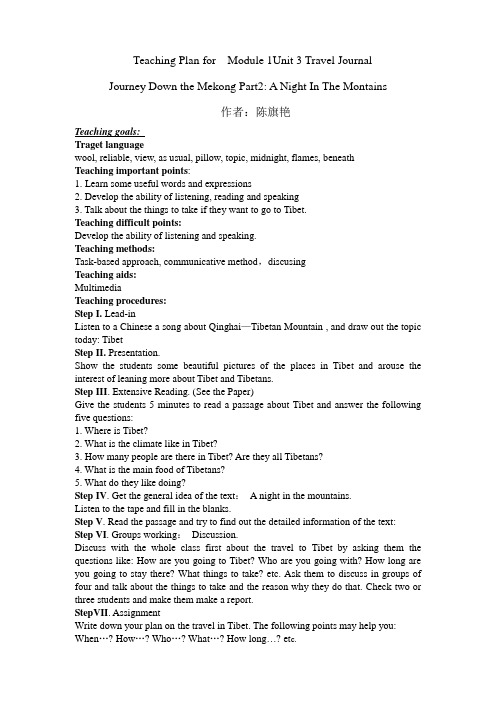
Teaching Plan for Module 1Unit 3 Travel Journal Journey Down the Mekong Part2: A Night In The Montains作者:陈旗艳Teaching goals:Traget languagewool, reliable, view, as usual, pillow, topic, midnight, flames, beneathTeaching important points:1. Learn some useful words and expressions2. Develop the ability of listening, reading and speaking3. Talk about the things to take if they want to go to Tibet.Teaching difficult points:Develop the ability of listening and speaking.Teaching methods:Task-based approach, communicative method,discusingTeaching aids:MultimediaTeaching procedures:Step I. Lead-inListen to a Chinese a song about Qinghai—Tibetan Mountain , and draw out the topic today: TibetStep II. Presentation.Show the students some beautiful pictures of the places in Tibet and arouse the interest of leaning more about Tibet and Tibetans.Step III. Extensive Reading. (See the Paper)Give the students 5 minutes to read a passage about Tibet and answer the following five questions:1. Where is Tibet?2. What is the climate like in Tibet?3. How many people are there in Tibet? Are they all Tibetans?4. What is the main food of Tibetans?5. What do they like doing?Step IV. Get the general idea of the text:A night in the mountains.Listen to the tape and fill in the blanks.Step V. Read the passage and try to find out the detailed information of the text: Step VI. Groups working:Discussion.Discuss with the whole class first about the travel to Tibet by asking them the questions like: How are you going to Tibet? Who are you going with? How long are you going to stay there? What things to take? etc. Ask them to discuss in groups of four and talk about the things to take and the reason why they do that. Check two or three students and make them make a report.StepVII. AssignmentWrite down your plan on the travel in Tibet. The following points may help you: When…? How…? Who…? What…? How long…? et c.。
Unit 3 Travel Journal 教学设计
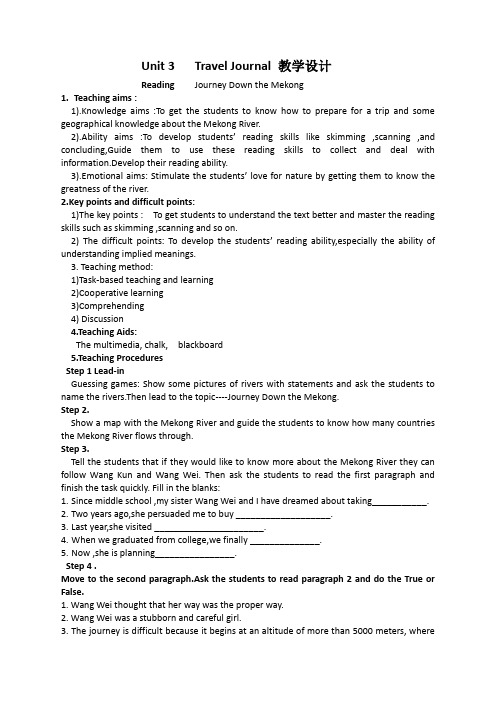
Unit 3 Travel Journal 教学设计Reading Journey Down the Mekong1.Teaching aims :1).Knowledge aims :To get the students to know how to prepare for a trip and some geographical knowledge about the Mekong River.2).Ability aims :To develop students’reading skills like skimming ,scanning ,and concluding,Guide them to use these reading skills to collect and deal with information.Develop their reading ability.3).Emotional aims: Stimulate the students’ love for nature by getting them to know the greatness of the river.2.Key points and difficult points:1)The key points : To get students to understand the text better and master the reading skills such as skimming ,scanning and so on.2) The difficult points: To develop the students’reading ability,especially the ability of understanding implied meanings.3. Teaching method:1)Task-based teaching and learning2)Cooperative learning3)Comprehending4) Discussion4.Teaching Aids:The multimedia, chalk, blackboard5.Teaching ProceduresStep 1 Lead-inGuessing games: Show some pictures of rivers with statements and ask the students to name the rivers.Then lead to the topic----Journey Down the Mekong.Step 2.Show a map with the Mekong River and guide the students to know how many countries the Mekong River flows through.Step 3.Tell the students that if they would like to know more about the Mekong River they can follow Wang Kun and Wang Wei. Then ask the students to read the first paragraph and finish the task quickly. Fill in the blanks:1.Since middle school ,my sister Wang Wei and I have dreamed about taking___________.2.Two years ago,she persuaded me to buy ___________________.st year,she visited ______________________.4.When we graduated from college,we finally ______________.5.Now ,she is planning________________.Step 4 .Move to the second paragraph.Ask the students to read paragraph 2 and do the True or False.1. Wang Wei thought that her way was the proper way.2. Wang Wei was a stubborn and careful girl.3. The journey is difficult because it begins at an altitude of more than 5000 meters, whereit is hard to breathe and very cold.4.When Wang Wei knew that their trip would not be an easy one, she became excited. Step5.Now please read the third paragraph and get to know the change of the Mekong River.Fill in the blanks.1.The Mekong River begins in on a Tibetan mountain. At first theriver is and the water is and .2.It becomes as it passes through deep ________, traveling acrosswestern Yunnan Province.3.Sometimes the river becomes a and enters widevalleys.4.After it leaves China and high altitude, the Mekong becomes ,and . As it enters Southeast Asia, its pace slows.5.It makes wide bends or meanders through low valleys to thewhere rice grows. At last, the river enters the South China Sea.Step 6. Choose the best answers according to the text.1. Compare with Wang Kun, what is Wang Wei's attitude towards the trip?A. more positive.B. less positive.C. the same positive.D.both not positive.2. From the passage we can infer(推断)that Wang kun is _______________.A. imaginativeB. stubbornC. sensibleD. risk-taking3. What does Wang Kun mean by saying“the proper way is her way”?A.Wang Wei is reliable,because she always knows the proper way.B.Wang Wei always insists on her way,even though she doesn't know the proper way.C.Wang Kun thinks his sister can't do anything properly.D. Wang Kun thinks that his sister can find the best way.Step 7. Extra task.Put the sentences in order.Each group will be given a piece of paper with one sentence on and then one member of each group will be asked to stand on the stage in order.1.Wang Wei can be really stubborn.2. The Mekong River enters the South China Sea.3.Wang Kun and Wang Wei have dreamed about taking a great bike trip since middle school.4.The Mekong River begins in a glacier on a mountain in Qinghai Province.5.They finally got the chance to take a bike trip after graduating from college.6.Once she has made up her mind, nothing can change it.Step 8. Homework1.R ead the text and find the long difficult sentences.2.Try to finish Exercise 2 on page 19 in the textbook.。
Unit 3 Travel journal 教案新部编本
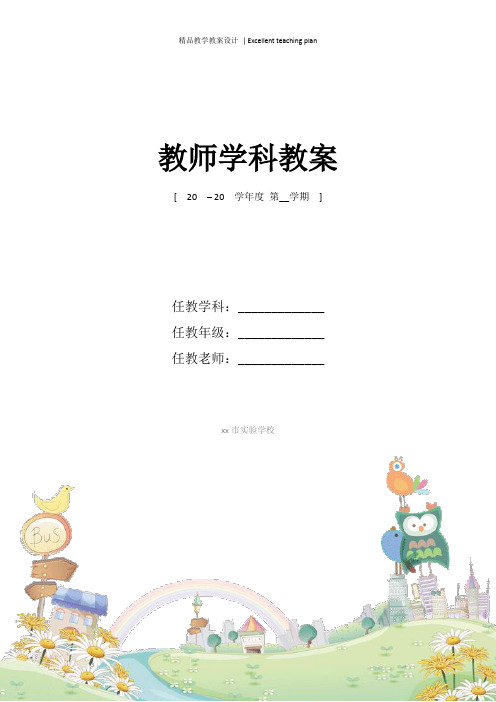
教师学科教案[ 20 – 20 学年度第__学期]任教学科:_____________任教年级:_____________任教老师:_____________xx市实验学校Unit 3 Travel Journal 单元教学目标I.Target language目标语言Ⅲ教材分析与组合1. 教材分析本单元以travel为主题,使学生通过travel了解他们所去国家或地区的风土人情,地理地貌及气候特征。
让学生体会英语作为工具给他们带来的乐趣。
学生可以利用英语扩大自己的视野,获取知识,了解世界。
学生可以通过相互讨论和相互交流以丰富各自的地理知识。
进一步扩大学生的词汇量。
能正确使用现在进行时的形式表达将来的计划和安排。
本单元把Travel Down the Mekong分成六部分,其中三部分作为阅读材料而另三部分作为听力材料。
通过本单元的学习使学生掌握一些重要词汇及词组,并能够写出自己的旅行日志来提高自己的写作水平。
1.1 Warming-up 让学生想象去旅游并选择一个地方为题,讨论所需费用,并决定四种交通方式,使学生了解旅行前的准备及计划。
1.2 Pre-reading 部分的三个问题是通过讨论河流在人民生活中的作用以及看图回答问题,让学生找到湄公河流域的国家,作为阅读的“热身”1.3 Reading 是日志的第一部分,它讲述了王坤和王薇的骑车旅行梦想和计划,描述了他们为这次旅游所做的准备,对旅游路线的选定以及他们通过查阅地图对湄公河情况的了解。
文章用第一人称的方式,通过对王薇做事的方式的介绍,让大家了解了她的性格特点,使人倍感亲切,给人留下深刻的印象。
日志的第二部分放在workbook 中,主要讲述他们在西藏山中度过的一宿,以及旅行中的苦与乐。
1.4 Comprehending第一题是信息题,通过问答使学生进一步理解课文以训练学生获取信息的能力。
第二题是理解题,让学生用自己的话解释课文中的句子。
Teaching PlanBook 1, Unit 3 Travel Journal 教案教学设计(
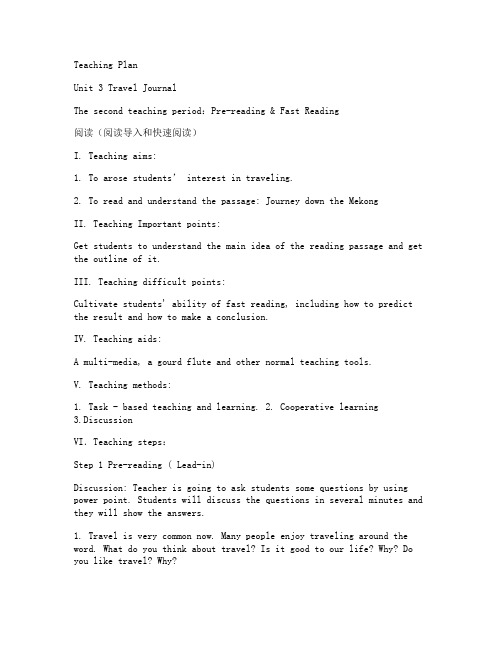
Teaching PlanUnit 3 Travel JournalThe second teaching period:Pre-reading & Fast Reading阅读(阅读导入和快速阅读)I. Teaching aims:1. To arose students’ interest in traveling.2. To read and understand the passage: Journey down the MekongII. Teaching Important points:Get students to understand the main idea of the reading passage and get the outline of it.III. Teaching difficult points:Cultivate students' ability of fast reading, including how to predict the result and how to make a conclusion.IV. Teaching aids:A multi-media, a gourd flute and other normal teaching tools.V. Teaching methods:1. Task - based teaching and learning.2. Cooperative learning3.DiscussionVI.Teaching steps:Step 1 Pre-reading ( Lead-in)Discussion: Teacher is going to ask students some questions by using power point. Students will discuss the questions in several minutes and they will show the answers.1. Travel is very common now. Many people enjoy traveling around the word. What do you think about travel? Is it good to our life? Why? Do you like travel? Why?2. There are many great rivers in the world. Do you think that river is important to people's life? why? Do you know some of them? And in which country are they?3. In southeast Asia, there is a great river linking six countries. What is the name of the river and which countries does it flow through?5. Match the rivers with their locations.6. Do you know something about the Mekong River?Step2 While Reading ( read the passage by three steps: fast reading, detail reading and deep reading)I. Fast ReadingPlease go through the passage quickly in five minutes and then answer the following questions:What's the main idea of the passage? And what about the main idea of each paragraph? What's their dream? Who takes part in the trip? Where are they going? How are they getting there? What can you see along the Mekong River?II. DebateWhich character do you like,Wang Kun or Wang wei? Why?III. DiscussionWhat do you think was right about the trip? Why? Write down your views on it and discuss with your teammates. (This open-up question makes students think about the eco-tour and train their oral English)Homework:1. Writing (about 100 words):Where did you visit? When did you take the trip? How did you get there? How do you think about the tourist attraction? What did you see? Do you have any other plan for tip?2. Try to tell the classmates the journey which you have taken.。
Unit3 Travel journal教案新部编本
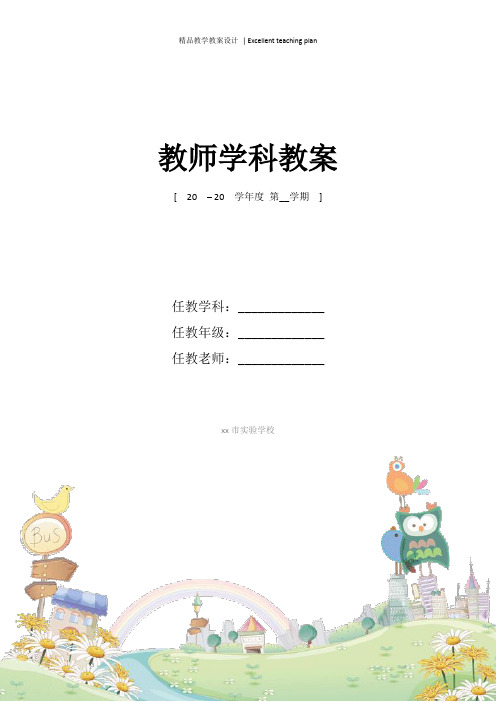
教师学科教案[ 20 – 20 学年度第__学期]任教学科:_____________任教年级:_____________任教老师:_____________xx市实验学校Teaching Plan for Book 1Unit3 Journey down the MekongPart 2 A night in the mountains——冯文娇教学内容分析:本课教学材料选自人民教育出版社出版的普通高中课程标准实验教材,高一年级必修一的第三单元Travel journal。
本单元主题是旅游,通过旅游日记的方式描述旅游见闻。
此节课是主阅读篇章故事的继续和延伸,记录了王坤和王薇姐弟两人在沿湄公河旅行途中在山间穿越,并在山上过夜的情形。
在充分利用教材资源的基础上,结合学生的实际情况设计教学活动,旨在帮助学生有效地掌握阅读技巧,形成有效地学习方法和阅读策略,同时了解记叙文篇章结构和写作特点,学会描述在旅游过程中的所见所感,为下一步进行旅行日志的写作教学做好准备。
I. Teaching aims (教学目标):Knowledge object(知识目标):1. To train students’ reading ability.2. To help students talk and write about travels.3. To make sure students can describe a journey they have experienced.Ability objects(能力目标):To develop students’ reading ability via di fferent types of skills, including skimming and detailed reading and their writing ability, etc.Moral objects(情感目标)Through teaching, arouse students’ interests in talking about travel and therefore, develop their love for nature.II. Teaching important points (教学重点)To make students master reading techniques: skimming and detailed reading.III. Teaching difficult points (教学难点)To develop students’ writing ability.IV. Teaching methods (教学方法)1. Task-based Language Teaching2. Cooperative studyV. Teaching aids (教具)Multi-media computer, blackboardⅥ. Teaching procedures &ways (教学过程与方式)Step 1. Lead-in and check-up (导入新课和展示预习成果)1. Use some pictures to lead in the new lesson.2. Check the students preview work.【设计意图】教师通过分享自己的旅游照片,可以把学生的注意力吸引到本课的主题上,激发学生学习的兴趣。
- 1、下载文档前请自行甄别文档内容的完整性,平台不提供额外的编辑、内容补充、找答案等附加服务。
- 2、"仅部分预览"的文档,不可在线预览部分如存在完整性等问题,可反馈申请退款(可完整预览的文档不适用该条件!)。
- 3、如文档侵犯您的权益,请联系客服反馈,我们会尽快为您处理(人工客服工作时间:9:00-18:30)。
Teaching Plan
Background information:
Students: Junior high school students, grade 1
Lesson duration: 35mins
Teaching contents: Unit3 Travel Journal---grammar: Present Continuous Tense-Expressing Futurity
Teaching aids: tapes, blackboard, chalk, PPT
Teaching aims: by the end of the lesson, students should be able to
◆Know the meaning and structure of the present continuous
tense----expressing futurity.
◆Make sentences fluently and correctly according to the structure
◆Distinguish the difference between this grammar point and the common
function of present continuous tense.
◆Know how to apply this grammar point in our real life.
Teaching difficulties:Students may mix up the present continuous tense---expressing futurity and the common function of present continuous tense.
Teaching methods:
✧Explorative learning: tape---listening and independent thinking
✧Cooperative learning: pair---work to create dialogue
✧Communicative approach
✧Task based teaching method
Teaching procedures: (25mins)
Step1: Review (5mins)
a)Teacher ask students to review they had learned about present
continuous tense(including the meaning and the structure)
b)Students make some examples using the structure
e.g.: We’re swimming. We’re running.
c) Students look at the PPT slides and memorize the main function of
present continuous tense.
Goal:1. Consolidate what students learn in class.
2. Practice their spoken English
Step2: learn the new function (10mins)
a)Listen to the tape first and understand the main idea.
b)After second listening, students answer the question.
c)Teacher shows the key sentences using the structure of present
continuous tense on the PPT
d)Students translate it and think about different function of the same
tense.
e)Students find different function of present continuous tense and
express it in their own words.
f)Teacher corrects students’mistakes and concludes the grammar
completely. (with PPT)
g)Teacher explains the grammar in depth and gives some examples.
Goal:1. Improve students’abilities of listening, independent thinking, translating.
2. Students know how to express themselves.
Step 3: grammatical exercise (5mins)
Goal: 1. Promote students’ linguistic competence
2. Consolidate what they learned in class
Step 4: A task (group work: two students a group) (5mins)
Students make a dialogue employing the grammar-----present continuous tense-expressing futurity and perform it.
Goal: 1. Promote students’ cooperative spirit and creativity.
2. Practice students’ spoken English
Blackboard design:(待写)。
